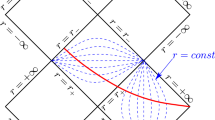Abstract
We consider generic axially symmetric rotating spacetimes and examine particle collisions in the ergoregion. The results are generic and agree with those obtained in the particular case of the rotating Teo wormhole in Tsukamoto and Bambi, Phys Rev D 91:104040, 2015. It is shown that for sufficiently rapid rotation, the energy of a particle escaping to infinity can become arbitrary large (so-called super-Penrose process). Moreover, this energy is typically much larger than the center-of mass energy of colliding particles. In this sense the situation differs radically from that for collisions near black holes.
Similar content being viewed by others
References
Bañados, M., Silk, J., West, S.M.: Phys. Rev. Lett. 103, 111102 (2009). [arXiv:0909.0169]
Piran, T., Katz, J., Shaham, J.: Astrophys. J. 196, L107 (1975)
Piran, T., Shaham, J.: Astrophys. J. 214, 268 (1977)
Piran, T., Shanam, J.: Phys. Rev. D 16, 1615 (1977)
Grib, A.A., Pavlov, Y.V.: Europhys. Lett. 101, 20004 (2013). [arXiv:1301.0698]
Zaslavskii, O.B.: Mod. Phys. Lett. A 28, 1350037 (2013). [arXiv:1301.4699]
Tsukamoto, N., Bambi, C.: Phys. Rev. D 91, 084013 (2015). [arXiv:1411.5778]
Teo, E.: Phys. Rev. D 58, 024014 (1998). [arXiv:gr-qc/9803098]
Zaslavskii, O.B.: Mod. Phys. Lett. A 31, 1650029 (2016). [arXiv:1506.02638]
Berti, E., Brito, R., Cardoso, V.: Phys. Rev. Lett. 114, 251103 (2015). [arXiv:1410.8534]
Zaslavskii, O.: Pis’ma ZhETF 92, 635 (2010) (JETP Lett. 92, 571 (2010)). [arXiv:1007.4598]
Parthasarathy, S., Wagh, S.M., Dhurandhar, S.V., Dadhich, N.: Astrophys. J. 307, 38 (1986)
Bejger, M., Piran, T., Abramowicz, M., Håkanson, F.: Phys. Rev. Lett. 109, 121101 (2012). [arXiv:1205.4350]
Harada, T., Nemoto, H., Miyamoto, U.: Phys. Rev. D 86 (2012). 024027 [Erratum ibid. D 86 (2012) 069902] [arXiv:1205.7088]
Zaslavskii, O.: Phys. Rev. D 86, 084030 (2012). [arXiv:1205.4410]
Schnittman, J.D.: Phys. Rev. Lett. 113, 261102 (2014). [arXiv:1410.6446]
Leiderschneider, E., Piran, T.: Phys. Rev. D 93, 043015 (2016). [arXiv:1510.06764]
Zaslavskii, O.: Mod. Phys. Lett. A 30, 1550076 (2015). [arXiv:1411.0267]
Leiderschneider, E., Piran, T.: [arXiv:1501.01984]
Zaslavskii, O.B.: Europhys. Lett. 111, 50004 (2015). [arXiv:1506.06527]
Patil, M., Harada, T.: [arXiv:1510.08205]
Zaslavskii, O. B.: [arXiv:1510.02140]
Tsukamoto, N., Bambi, C.: Phys. Rev. D 91, 104040 (2015). [arXiv:1503.06386]
Zaslavskii, O.B.: Phys. Rev. D 84, 024007 (2011). [arXiv:1104.4802]
Bardeen, J.M., Press, W.H., Teukolsky, S.A.: Astrophys. J. 178, 347 (1972)
Kleihaus, B., Kunz, J.: Phys. Rev. D 90, 121503(R) (2014). [arXiv:1409.1503]
Smarr, L.: Phys. Rev. Lett. 30, 71 (1973)
Zaslavskii, O.B.: Phys. Rev. D 92, 044017 (2015). [arXiv:1506.00148]
Kashargin, P.E., Sushkov, S.V.: Grav. Cosmol. 14, 80 (2008). [arXiv:0710.5656]
Kashargin, P.E., Sushkov, S.V.: Phys. Rev. D 78, 064071 (2008). [arXiv:0809.1923]
Bronnikov, K.A., Krechet, V.G., Lemos, J.P.S.: Phys. Rev. D 87, 084060 (2013). [arXiv:1303.2993]
Ogasawara, K., Harada, T., Miyamoto, U.: [arXiv:1511.0011]
Zaslavskii, O.B.: Phys. Rev. D 93, 024056 (2016). [arXiv:1511.07501]
Acknowledgments
This work was funded by the subsidy allocated to Kazan Federal University for the state assignment in the sphere of scientific activities.
Author information
Authors and Affiliations
Corresponding author
Appendix
Appendix
Here, we prove inequality (35). As \(L_{1}\le 0\), \(K\ge K_{+}\) where \( K_{+}\) corresponds to the maximum possible value of \(E_{3}=E_{+}+s\). Therefore, it is sufficient to show that \(K_{+}>0\). Using (15), (33), (39) one finds
where
By assumpion, the point of collision is located inside the ergoregion, where (29) is satisfied, hence
It is seen from (57) that \(B<1\). Then,
The coefficent \(a_{1}\) can be rewritten as
where
Using the inequality \(B<1\) again,
It follows from (85) that
Thus, since \(L_{1}\le 0\), all terms in (81) are positive or, at least, non-negative. This completes the proof.
Rights and permissions
About this article
Cite this article
Zaslavskii, O.B. Rapidly rotating spacetimes and collisional super-Penrose process. Gen Relativ Gravit 48, 67 (2016). https://doi.org/10.1007/s10714-016-2063-0
Received:
Accepted:
Published:
DOI: https://doi.org/10.1007/s10714-016-2063-0




